Geek Articles
Practical Use of Field Curvature: 24-70mm Zooms
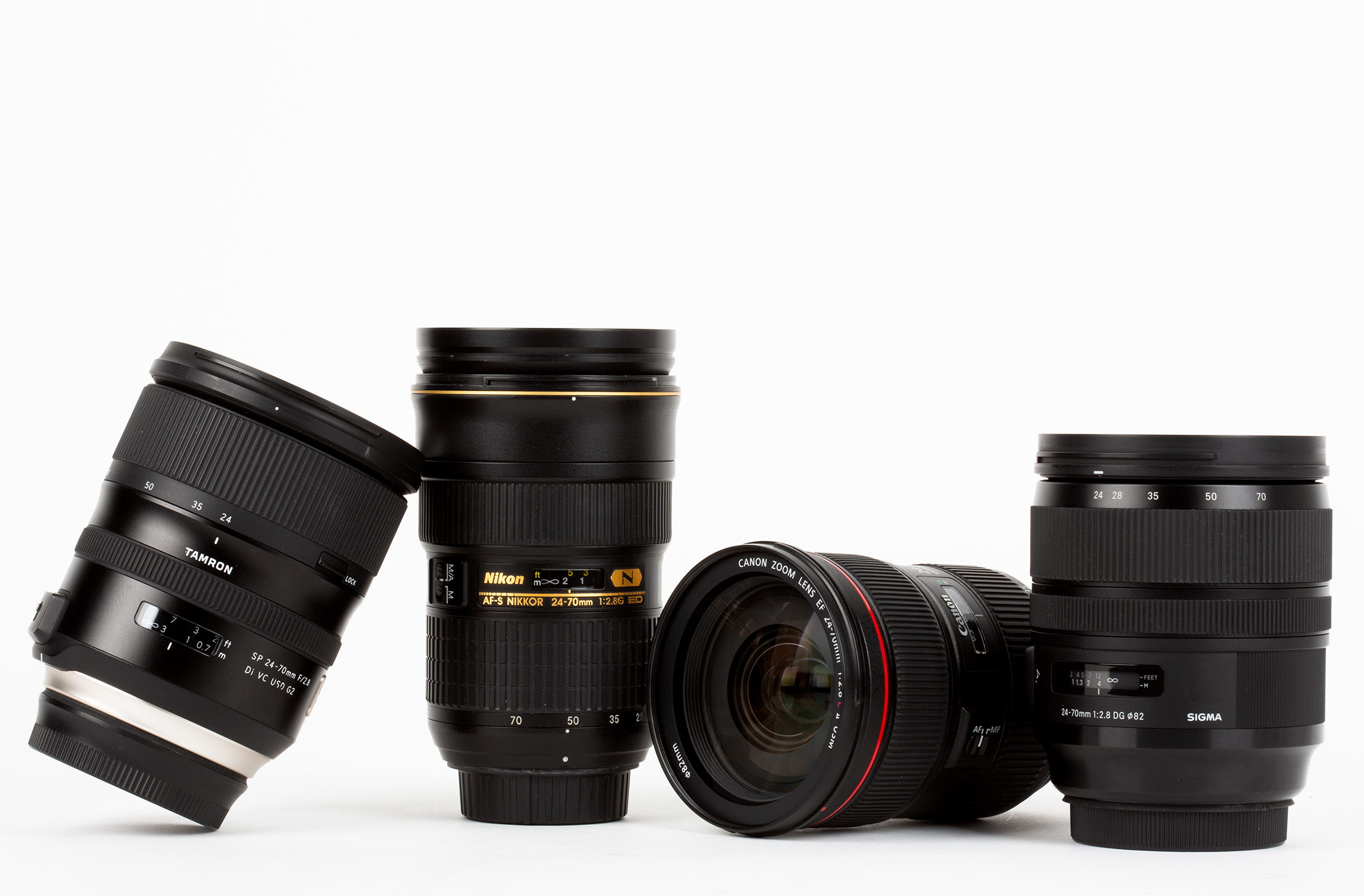
We’ve done a pretty good introduction to the field curvatures of 24mm, 35mm, 50mm, and 85mm prime lenses. We made a little bit of comparison with bargain primes and zoom lenses at 35mm. This post is going to assume you are familiar with those previous posts. (Yes, I know the reality is most people read the title, look at the pictures, and then go straight to a forum to comment that I’m wrong.)
Today I want to do a little bit of a deeper dive into how zooms behave. We’ll start with 24-70mm lenses for two reasons. First, because this will overlap the primes we’ve been testing, giving us a helpful comparison. Second because 24-70mm zooms for SLRs, at least, have to do the complicated trick of zooming from a retrofocus lens at the wide end to a telephoto lens at the long end. They are the ultimate compromise.
I also should mention that this post isn’t me showing you what I already know, exactly. We haven’t done this type of comparison before, so I’ll be learning as we go just like you. I have some expectations, though. I expect zooms to vary more than primes with field curvature since they vary more with MTF. Even stopped down, I expect primes will generally perform a bit better, but since we’re testing at f/5.6, the difference shouldn’t be huge. At f/2.8, it would be.
Field Curvature Variation
One thing we should talk about right off the bat is that zoom lenses have more variation of field curvature than prime lenses and that the variation can change as you zoom. Below I have the sagittal and tangential fields of 5 copies of a 24-70mm f/2.8 lens measure at 24mm, 35mm, and 70mm.
24mm
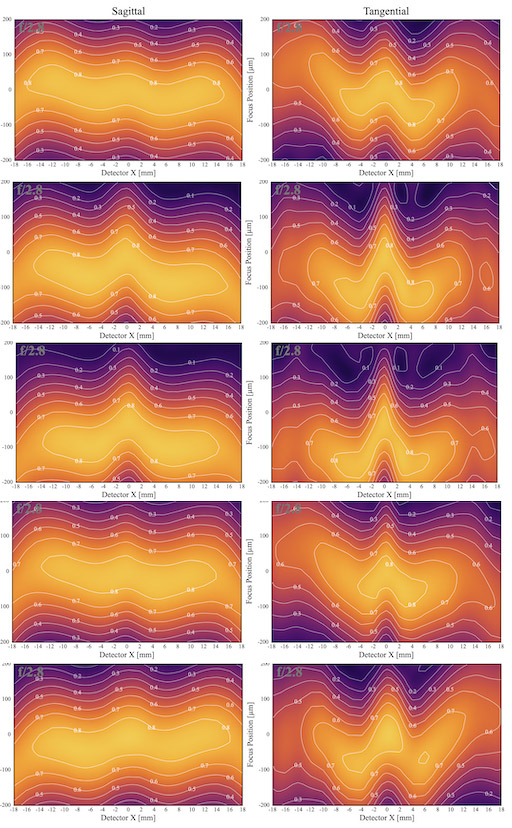
Lensrentals.com, 2020
35mm

Lensrentals.com, 2020
70mm
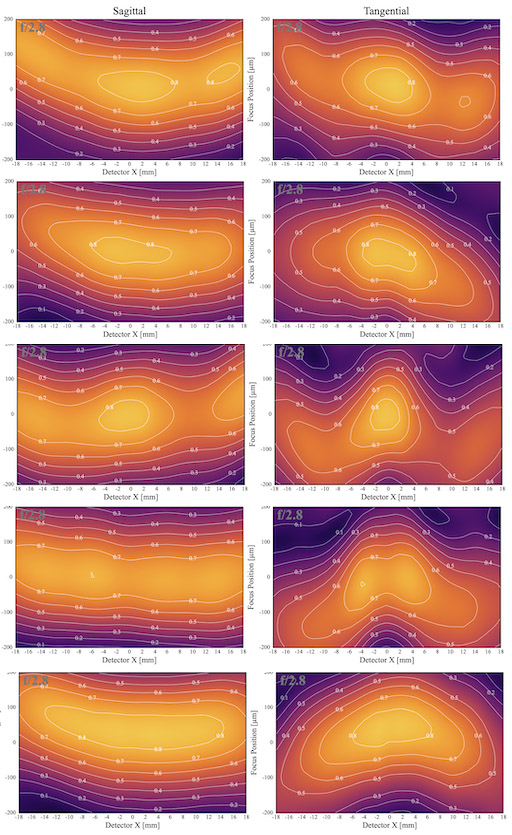
Lensrentals.com, 2020
You probably notice that they’re all pretty similar at 24mm, somewhat similar at 35mm, and a bit random at 70mm. You might also have noticed that overall sharpness is a bit lower as you lengthen the zoom, too. This is pretty typical for all zooms; they behave better at some focal lengths than others. While I can’t say it’s always the case, I do know that most zoom designs start life as a prime design that is then modified to be a zoom. I assume the ‘better’ focal length is generally where the design started.
Note: this isn’t exactly true today. Most zoom designs start from existing zoom designs that are modified. Some may (although I doubt it’s frequent) start as fresh designs. But historically, ‘modified prime’ is how it happened.
There’s one other thing to discuss. When you look at the different field curvature graphs above, there isn’t generally a ‘right’ graph. From a sharpness standpoint, all of those are quite acceptable for this lens. It’s possible (and again, I’m speculating) that as the lens is optically adjusted for acceptable sharpness, some variation of field curvature is an inevitable side effect.
Comparing 24-70 Zooms
We’ll start by showing field curvatures for several excellent quality 24-70mm zooms at three focal lengths and f/5.6.
Canon 24-70mm f2.8 L II
One thing to note right away; the fields are tilted, and the tilt changes direction as you zoom in this copy. Get over it. It’s a zoom. Most zooms tilt, and lots of zooms change tilt at different focal lengths. If you look at a teardown and see how the zoom group rotates when it zooms, it’s not surprising the tilt varies.
24mm
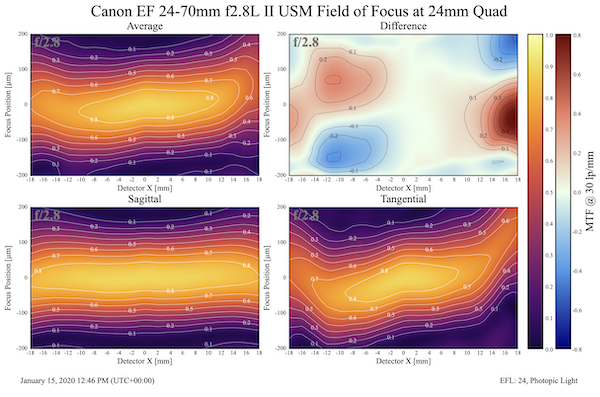
Lensrentals.com, 2020
35mm
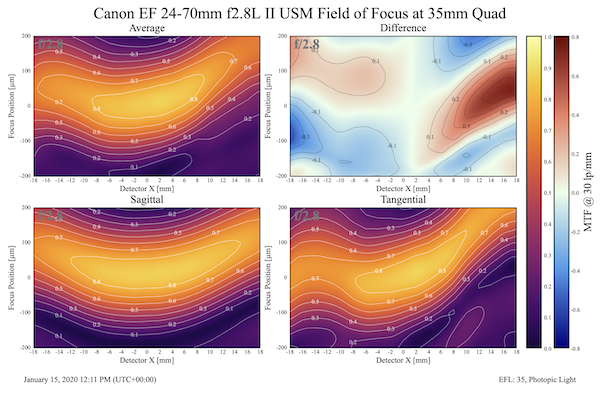
Lensrentals.com, 2020
70mm
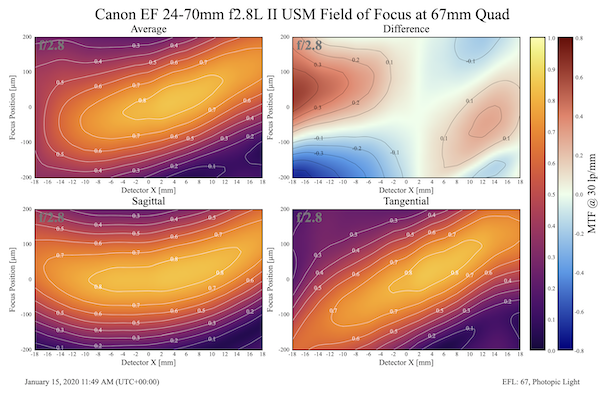
Lensrentals.com, 2020
Sony 24-70mm f2.8 GM
The Sony has a very similar 24mm pattern to the Canon, although a bit more pronounced tangential curve.
24mm
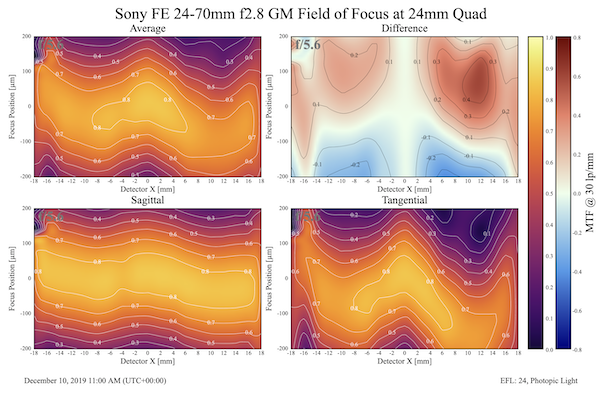
Lensrentals.com, 2020
45mm
The Canon had flattened out the tangential curve by 35mm and turned to a bit of a shallow “U” shape, but the Sony maintains the same curve as 24mm our to the 45mm range. This isn’t a better-worse or right-wrong thing; it’s just a difference.
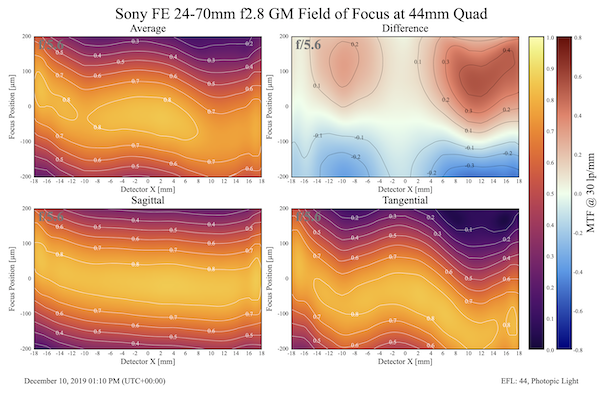
Lensrentals.com, 2020
70mm
At 70mm the Sony has a very flat sagittal and hump-shaped tangential field with a bit more astigmatism in the outer 1/3.
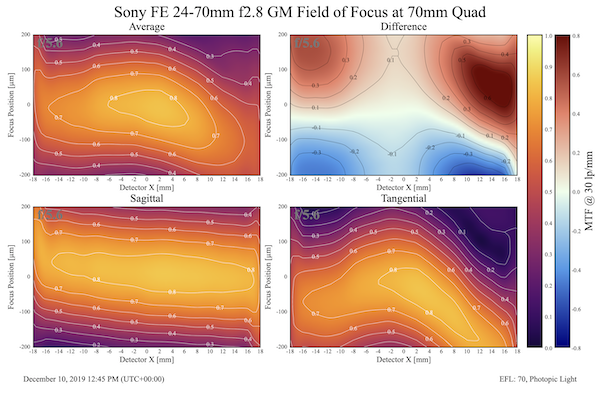
Lensrentals.com, 2020
Sigma 24-70mm f2.8 Art
24mm
At 24mm, the Sigma sagittal and tangential curves, while different, are of similar shape. Because of that, as you can see in the Difference graph, there’s less astigmatism.
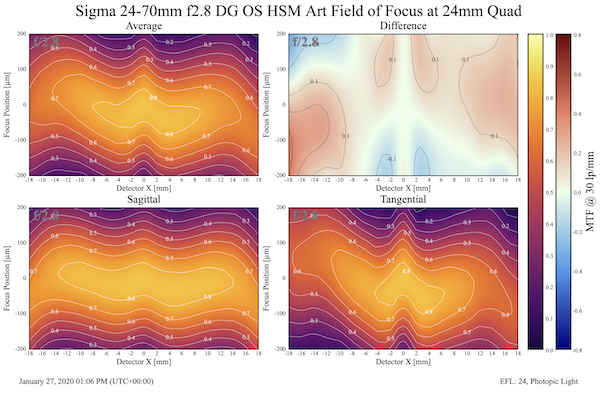
Lensrentals.com, 2020
35mm
The tangential, much like the Sony doesn’t change much in the middle range.
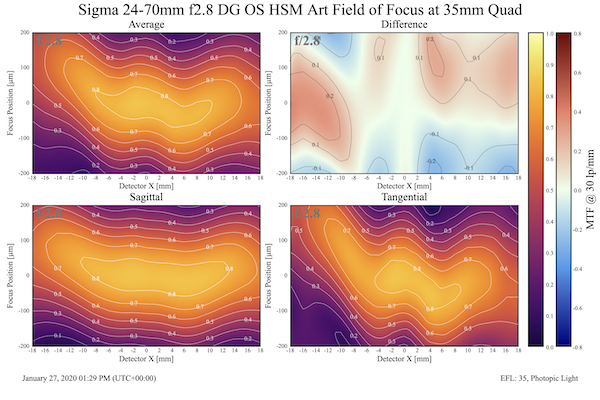
Lensrentals.com, 2020
70mm
It does flip to a center peak at the long end, and now there is more astigmatism, again much like the Sony.
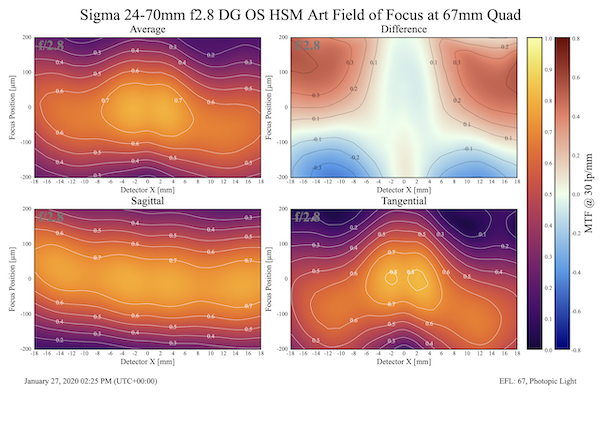
Lensrentals.com, 2020
Canon 24-70mm f/4 IS L
I just included this one because it was an f/4, stabilized, and has a simple macro (basically a built-in extension tube) mechanism. I thought that might make its field curvatures a bit different, but it really doesn’t.
24mm
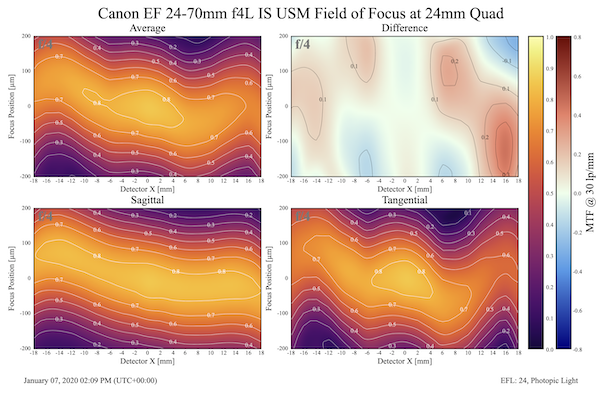
Lensrentals.com, 2020
35mm
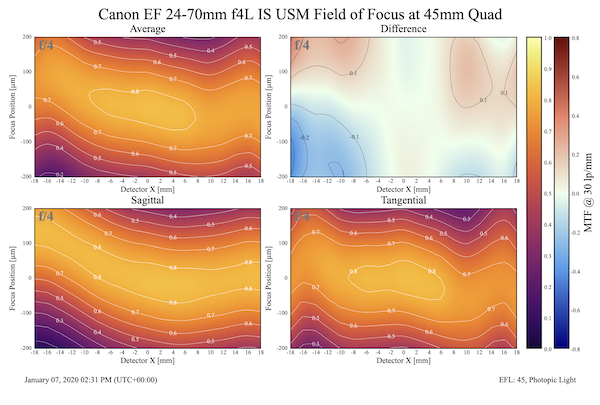
Lensrentals.com, 2020
70mm
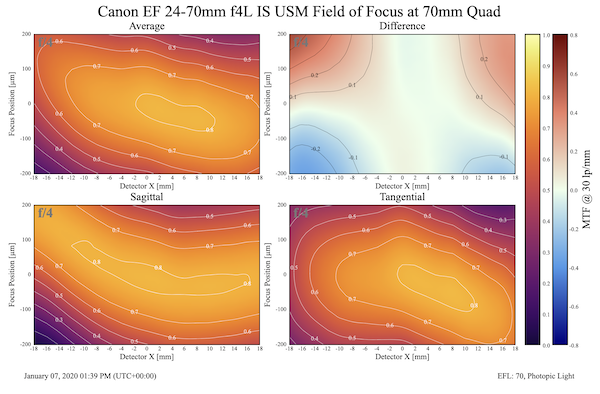
Lensrentals.com, 2020
So What Did We Learn Today?
I learned a couple of things. First, we already knew from MTF testing that zooms tend to have tilts, and the tilts can change at different focal lengths. We also knew that zooms have more sample variation, and I wasn’t too shocked to find that the field curvature could vary between copies. (Just because it will come up, yes, we tested more copies than you see here. We try to keep even my blog posts at a reasonable length.) At 24mm, the field curvatures of the zooms were somewhat similar in shape to the 24mm primes.
There were a couple of things that surprised me. First, if you go back and look at our articles on 24mm prime and 35mm prime field curvatures, you’ll notice that the primes generally have more curved fields than these zooms did at those focal lengths. The zooms also tended to have less curvature at 70mm than either 50mm or 85mm primes. This did surprise me a bit.
I can think of several possible reasons this would be so, although I don’t KNOW why it is so. I’m speculating. All lens designs are compromises meant to trade-off various aberrations and leave a sharp lens behind. Wide-aperture lens designs may be more likely to allow field curvature to minimize other aberrations and maximize sharpness. Or it could be that since field curvature changes as you zoom, it is more important to minimize field curvature of a zoom lens, and sacrifice other things.
What would this mean in real life? Well, one thing that occurs to me is that while primes are sharper than zooms in the edges, even stopped down, the lesser field curvature of zooms might make this less obvious. In other words, the zoom is only 80% as sharp as the prime in the outer parts of the image, but the prime’s field curvature is such that the 100% sharp part happens to be out of the field of focus of some images. Or something like that.
Does that mean Roger has now decided zooms can be as good as primes? Oh, hell no. But they can be plenty good enough and give you a lot more flexibility.
What it really means is there is the performance that can be wrung out of a lens if you really, really know your lens. Know where in the image it works best and where it works worst and plan your photographs accordingly. And that, my friends, is one of the things that separates great photographers from good ones.
You don’t need a bunch of fancy laboratory equipment to determine these characteristics. Shooting a few carefully framed shots, with or without using something like a Photoshop Find Edges filter, will show you what you need to know about each lens you carry.
Roger Cicala
Lensrentals.com
February, 2020
Author: Roger Cicala
I’m Roger and I am the founder of Lensrentals.com. Hailed as one of the optic nerds here, I enjoy shooting collimated light through 30X microscope objectives in my spare time. When I do take real pictures I like using something different: a Medium format, or Pentax K1, or a Sony RX1R.
-
Patrick O’Connor
-
Federico Ferreres
-
bdbender4
-
Matti6950 .
-
Roger Cicala
-
Matti6950 .
-
Nqina Dlamini
-
JP
-
Roger Cicala
-
Roger Cicala
-
Roger Cicala
-
Roger Cicala
-
JP
-
Athanasius Kirchner
-
Andreas Werle
-
Brandon Dube
-
Andreas Werle
-
Paul Beavin
-
Roger Cicala
-
Roger Cicala
-
starnavig8r
-
John Dillworth
-
?ukasz Moszczy?ski
